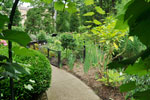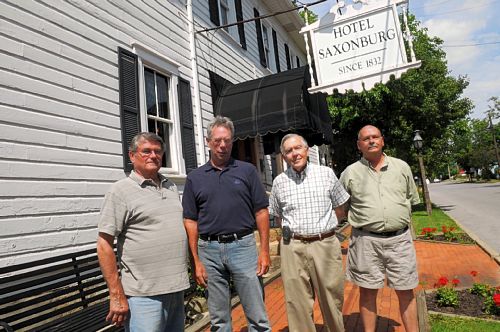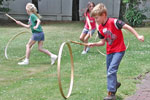
Category Archive: National Historic Landmarks
-
Historical Groups Left in Lurch by Funding Cuts
By Richard Robbins, Pittsburgh TRIBUNE-REVIEW
Sunday, July 25, 2010
Museum inn keeper and Curator Jim Koontz, of Ligonier, builds a birdhouse that is being modeled after the Laughlintown museum's cook house. Barry Reeger/Tribune-Review
Just two years ago, Soldiers & Sailors Memorial Hall & Museum, the Oakland landmark honoring veterans of all of America’s wars, was on the receiving end of a nice piece of change from Pennsylvania: $260,000.
In 2009, the state’s largesse shrank dramatically, to a mere $30,000.
This year, Soldiers & Sailors is in line to get nothing, a result of a state budget that eliminated grants for historical sites, from the 218-acre Bushy Run Battlefield in Penn Township to the smallest local historical society.
The funding cuts will have a huge impact on groups devoted to local history, according to Ronald Gancas, Soldiers & Sailors president and CEO.
He foresees severe retrenchments, including the continuation of a wage freeze in effect at Soldiers & Sailors since 2007 and the need to recruit and mobilize even more volunteers. The museum’s education department has gone from five full-time and two part-time employees a few years ago to one full-time and one part-time employee today.
“If this trend continues, it will take 50 years to put things back together,” Gancas said.
The 2009 state budget contained $1.7 million for regional and local history, a sum that the state House added after several months in which it appeared there would be no funding for historical groups.
But this time around, there was no late change to rescue local history grants, either for general operations or special projects.
There was lip-service support for public history from members of the General Assembly but nothing more, said Deborah Filipi, executive director of the Pennsylvania Federation of Museums and Historical Organizations.
“We are in a crisis, there is no doubt about it,” Filipi said. “There are some museums that are already hurting. I suspect some of these are not going to survive.”
Jeremy Burnworth, president of the Fayette County Historical Society, said the funding cuts could not come at a worse time for his group, which conducted a ribbon-cutting ceremony Friday at its new museum and headquarters in a renovated 1700s building.
“This is really bad timing,” Burnworth said, adding that the historical society will be “held back without” the state dollars. He was counting on $10,000 from the state and a $10,000 match from the county to help staff the museum and the Searight Tollhouse, both along the National Road.
“We were on track” for the funding, Burnworth said. Now the game plan is to utilize volunteers in place of paid staff.
Tina Yandrick, director of operations for the Ligonier Valley Historical Society, said the expiration of funding meant elimination of summer internships cutting general maintenance “over and above the usual.”
Yandrick noted Compass Inn, a restored Laughlintown stagecoach stop built in 1799, “always” needs refurbishing.
Nevertheless, she said, “we are fortunate we have Compass Inn,” a money-maker for the society that helps to offset the loss of state money.
State funding was “always important money for us,” said Lisa C. Hays, executive director of the Westmoreland County Historical Society, adding that money has been so scarce, “I’m trying to get through this month.”
“We’ve already tightened our belts a lot,” Hays said. She forecast the potential for shorter business hours beginning in 2011 to “save staff time.” However, because the society likely will make a greater effort to raise private dollars, Hays was uncertain if savings are actually possible.
-
170-Year-Old Tavern in Menallen to Serve Up the Past
By Mary Pickels
TRIBUNE-REVIEW
Thursday, July 22, 2010
Fayette County Historical Society President Jeremy Burnworth is in the restored main room on the second floor of the former Abel Colley Tavern, which will is the society's headquarters. Barry Reeger | Tribune-Review
The Fayette County Historical Society Friday will hold a grand opening of its museum, to be housed in the former Abel Colley Tavern in Menallen.
Open to the public, the 3 p.m. program will showcase the restored red-brick structure at 7083 National Pike.
Last July, Warren and Virginia Dick of Smithfield donated the 170-year-old building to the historical society. Volunteers helped to restore the property, which is listed on the National Register of Historic Places.
Society President Jeremy Burnworth credited volunteer Tom Buckelew and former intern Bill Zinn, along with inmates from the State Correctional Institution at Greene, who performed labor through the Community Works Program, for much of the renovation.
Community volunteers pitched in to paint walls, install moulding and restore hardwood floors.
Although some work remains, the majority of the main rooms have been restored, Burnworth said.
Photos to be displayed Friday will show the “before” and “after,” he said. “You will be able to see (the volunteers’) accomplishments in a short amount of time. We want to let people see the beautiful work that has been done.”
Additional work will help take the structure to its next level, becoming a museum, Burnworth said.
“It’s Fayette County’s first-ever historical museum,” he said. “It’s kind of a big deal.”
Friday’s program will include local government officials, Dick family members and representatives from the National Road Heritage Corridor and the Sen. John Heinz History Center. The historical society is an affiliate of the history center and may benefit in the future through a display of Civil War memorabilia, Burnworth said.
In the future, the site will be used for the society’s headquarters. It will be available for fundraisers and meetings.
Donations of historical artifacts pertaining to Fayette County are welcome.
“They can go way back, 50 to 250 years old,” Burnworth said. “For example, think of veterans.”
There has been no place in the county to display photos, uniforms, letters or furniture, he noted.
“We are afraid people will be throwing things away,” he said. “We really want a situation in place, so even if family members are not interested, we can protect and archive (those items). We get lots of calls for information, requests to come to the building and look at the archives and all of the things people think we have.”
Plans include a gift shop, likely to include publications and books on the region’s history. In acknowledgement of the building’s history, keepsake mugs will be sold on Friday.
Public visitation hours have not been set.
“The committee will help determine the direction of ‘what’s next,'” Burnworth said.
For more information, or to donate or volunteer, visit the society’s website at www.fayettehistory.org. Anyone interested in attending Friday’s opening or joining an advisory committee is asked to call 724-439-4422.
-
Neighbors in the Strip Accredited as a National Main Street Program
Wednesday, July 21, 2010
Pop City Media
Neighbors in the Strip, a non-profit organization dedicated to promoting economic development in the Strip District, has been awarded designation as an accredited National Main Street Program by the National Trust for Historic Preservation.
The prestigious designation is based on a ten point set of criteria, which ultimately demonstrates that an organization has leveraged local historic and business assets to thoroughly promote revitalization of a neighborhood business district.
Neighbors in the Strip was formed in 1999 by stakeholders wishing to better promote economic transformation in the neighborhood, while maintaining its historic character. A decade ago, “the perception of crime in the strip was very high,” notes Becky Rodgers, Executive Director of NITS. “Looking back over the past ten years, with a lot of hard work from the police, the DA’s office, and the stakeholders, crime has decreased in the Strip by 58 percent. If you want to keep economic development happening, you have to keep crime down.”
In addition to making the neighborhood safer, NITS works with local proprietors to promote business. In fact, forty new businesses are scheduled to open soon, including a public market, which will be opening in August.
“We’re mainly zoned urban-industrial in the Strip, which is sort of the wild west of zoning,” says Becky. “So when a new project comes along, there are certain zoning exceptions that have to go in front of the zoning board, and we go with business owners to the board to support those variances.”
Other factors that lead to the Main Street designation include NITS’ strong cooperation with its partners, which include the City, the URA, and a large number of non-profits, as well as the substantial grant programs they offer. Neighbors in the Strip has played a key role in helping the neighborhood evolve into a residential area in the 2000’s, aided by their Upper Floor Grant, which encourages the residential development of underutilized floors above commercial businesses.
Sign up to receive Pop City each week.
Source: Becky Rodgers, Executive Director of Neighbors in the Strip
Writer: John Farley -
Rodef Shalom’s Garden Grows into Latest Exhibit of Wearable Greens
By Alaina Raftis , TRIBUNE-REVIEW
Thursday, July 15, 2010
The heavily cultivated and well-maintained garden -- which sits on a third of an acre off of Fifth Avenue in Oakland -- was created by Irene Jacob, a botanist who founded the docent program at Phipps Conservatory and Botanical Gardens, and her husband, Rabbi Walter Jacob, to bring people closer to the Bible in a nontraditional way. Justin Merriman | Tribune-Review
The lush greenery at Rodef Shalom’s Biblical Botanical Garden is celebrating it’s 25th year with a new exhibit titled “What Shall I Wear?”
This year, the garden showcases various plants and flowers that have been used to make clothing and fragrances for thousands of years.
The heavily cultivated and well-maintained garden — which sits on a third of an acre off of Fifth Avenue in Oakland — was created by Irene Jacob, a botanist who founded the docent program at Phipps Conservatory and Botanical Gardens, and her husband, Rabbi Walter Jacob, to bring people closer to the Bible in a nontraditional way.
Often referred to as “Little Israel” because its geography replicates the confines of the Holy Land, the garden features various miniature landmarks such as Mt. Hermon, a mound of stones stacked beneath the shade of the billowing Acacia trees, and the Jordan River, a tranquil stream of water trickling from one corner of the garden to another.
The thousands of signatures penned in the guest book each season are only one sign of the garden’s success.

Often referred to as "Little Israel" because its geography replicates the confines of the Holy Land, the garden features various miniature landmarks such as Mt. Hermon, a mound of stones stacked beneath the shade of the billowing Acacia trees, and the Jordan River, a tranquil stream of water trickling from one corner of the garden to another. Justin Merriman | Tribune-Review
“This is the largest and most complete garden of its kind,” says Arlyn Gilboa, who has been a docent at the garden for 15 years, “It’s wholly dedicated.”
The garden contains 56 out of 110 plants specifically mentioned in the Bible and an additional 50 flowers that Jacob added to awaken the verdant oasis.
“Some people come to Pittsburgh just to see the garden,” says Jean Simon, another docent.
Plants that aren’t mentioned in the Bible were given creative names such as, “Jacob’s Coat,” “Angel’s Tears” and “Elijah’s Blue” to play along with the biblical theme.
This year’s exhibit “was just something new that we haven’t focused on before,” Gilboa says. “Sometimes our exhibits don’t have biblical roots, but this year it certainly does.”

The garden contains 56 out of 110 plants specifically mentioned in the Bible plus more. Justin Merriman | Tribune-Review
Some of the plants featured in this year’s exhibit are used for the essential oils in perfumes and fragrances. They include, among others, banana shrubs, carnations, chamomile, gardenia, geranium, jasmine, kumquat, lemon verbena, mock orange, musk plant, myrtle, patchouli, rose, rosemary and sage. The cotton and flax plants also are displayed and both have been used to make clothing since the ancient times.
“It’s a wonderful thing,” Gilboa looks at the two massive Cedar of Lebanon trees at the entrance to the garden. “The fact is that the ancients were dependent on plants, and so are we. For me, I feel a strong connection with Jewish history when I’m here. It’s such a treat.”
Rodef Shalom Biblical Botanical GardenWhen: Through Sept. 15. Hours: 10 a.m.-2 p.m. Sundays-Thursdays; 7-9 p.m. Wednesdays; noon-1 p.m. Saturdays Guided tours available 12:15-1 p.m. Aug. 6 and Sept. 3
Admission: Free
Where: Rodef Shalom Temple, 4905 Fifth Ave., Oakland
Details: 412-621-6566
-
Kids Can Get Hands on With Historical Games at Old Economy Village
By Kellie B. Gormly, PITTSBURGH TRIBUNE-REVIEW
Thursday, July 15, 2010Long before the days of battery-operated Buzz Lightyear toys and Wiis, kids had to get pretty creative in order to make toys and play games.
Children in the 19th century would amuse themselves with activities like rolling hoops with sticks, and doing “Lady Ann’s ring tosses,” which involved a stick tied to a wooden circle about the size of a doughnut. Kids would toss the stick around, and try to catch the circle with it. In another old-fashioned game, quoits, people would throw rings to land around a peg in the ground. Many of the toys were made with scrap wood that came from building houses.
“They had to make their own toys, mostly,” says Lynn Popovich, who is organizing a play-themed event at Old Economy Village this weekend. “You couldn’t go to the store and buy them. … Most of the toys back then were creative things that the parents sort of invented when the kids were little to keep them busy.”
On Saturday, Old Economy Village — which re-opened in April, after a state budget crisis closed the National Historic Landmark for a few months — will let its visitors explore, learn about and try out toys and games from the 1800s, when the Harmonists from Germany settled the Beaver County village. Hands On History Day features the old-fashioned amusements, along with arts and crafts, sack races, a historical scavenger hunt, and more. Kids can get their pictures taken while wearing reproduction 19th-century clothing, attend an 1830s schoolhouse session, watch puppet shows, play old instruments like kazoos, and more.
The activities will allow visitors of all ages to step back in time and enjoy getting a feel for early American life, says Popovich, who is the village’s volunteer coordinator and store manager.
“We just want them to come and have a fun time and experience the days of yore … with their children,” she says. “It’s something for the entire family. There aren’t a lot of activities where kids and parents can enjoy themselves together. They can walk around the garden, pavilion and gazebo, sit on the bench and reflect how people lived back then.
Kids, Popovich says, are “fascinated, I think, with how the children of yesterday lived, without the modern conveniences.”
“They love playing with the old-fashioned toys,” she says. “You wouldn’t think that they’d be interested because they’re so involved with iPods .. and all that high-tech stuff.”
Hands On History Day includes demonstrations from a blacksmith, weaver, broommaker, baker and other artisans, and visitors can try out these activities, Popovich says. The Ambridge Steel Drum Band will be performing at 1 and 3 p.m. Hot dogs, drinks and other snacks will be sold.
During school tours at the village, she says, the kids are fascinated by how their predecessors amused themselves without batteries and electricity.
_______________________________________________________________________________________
Hands On History Day_______________________________________________________________________________________When: 10 a.m.-5 p.m. Saturday
Admission: $9 for age 11-64; $6 for ages 3-11; $8 for age 65 and older; free for age 2 and younger
Where: Old Economy Village, 270 16th St., Ambridge, Beaver County
Details: 724-266-4500 or website
-
Former Turtle Creek High School’s Architecture, Importance Honored
By Tom Fontaine
PITTSBURGH TRIBUNE-REVIEW
Thursday, July 15, 2010
On Saturday, officials will unveil two historical markers that commemorate the former Turtle Creek High School building's architectural significance and role in the community. Officials debated about demolishing the building five years ago, but a group led by former graduates Jill Hinkle, Bob Mock, Jeanne Flaherty and Connie Morenzi led vocal opposition. The Classical Revival-style, cream-colored brick building with stone and terra cotta trim was designed by Pittsburgh architect George Henry Schwan. Jasmine Goldband | Tribune-Review
The former Turtle Creek High School building has gone by several names and narrowly avoided the wrecking ball to remain a community centerpiece since opening during World War I.
On Saturday, officials will unveil two historical markers that commemorate the Monroeville Avenue building’s architectural significance and role in the community.
Although the markers were installed last week, the building was placed on the National Register of Historic Places three years ago and received historic designation last fall from the Pittsburgh History and Landmarks Foundation.
“It basically validates what people in Turtle Creek have felt all along,” said councilwoman Jill Henkel of the markers. Henkel is a 1978 graduate of the former Turtle Creek High School and one of four Turtle Creek natives who led a push to obtain historical designation for the building.
Ground was broken on the $200,000 building in August 1917, and it opened in February 1919 as Union High School, with students from Turtle Creek, Wilmerding, East Pittsburgh and parts of nine other communities, according to documents related to the National Register of Historic Places designation.
The Classical Revival-style, cream-colored brick building with stone and terra cotta trim was designed by Pittsburgh architect George Henry Schwan. He also designed the Twentieth Century Club’s original building in Oakland, the former Oakmont High School and laid out plans for factory-worker developments in Aliquippa and Akron, Ohio.
The building wasn’t home to just high school classes.
Westinghouse employees trained at night in classrooms and vocational shops. Women used school sewing machines after hours to earn money during the Great Depression. And the school’s large lawn provided “the only open green space in the borough,” Henkel said.
“Even today, people are always playing in it,” Henkel said of the lawn. “It’s basically a community park.”
The school would hit a peak enrollment of more than 2,100 students in the 1930s. Also in that decade, after East Pittsburgh and Wilmerding opened their own high schools, Union’s name was changed to Turtle Creek High School. In 1940, the school graduated just 365 students.
When Turtle Creek became part of the newly created Woodland Hills School District in the 1980s, the building became the new district’s East Junior High. Officials debated about demolishing the building five years ago, but a group led by former graduates Hinkle, Bob Mock, Jeanne Flaherty and Connie Morenzi led vocal opposition.
Ultimately, the district moved East Junior High students elsewhere and mothballed the Turtle Creek building for the 2008-09 school year; it reopened last August, housing the district’s new Woodland Hills Academy for elementary students.
“I would have laid down in front of the bulldozer if they tried to tear down the building,” said Mock, a 1968 graduate.
The unveiling of the marker, part of Turtle Creek Community Days festivities, begins at 7:30 p.m. on Saturday at 126 Monroeville Ave.
-
Historic Old Stone Tavern in Pittsburgh’s West End Awaits New Life
By Tony LaRussa
PITTSBURGH TRIBUNE-REVIEW
Monday, July 12, 2010
The Old Stone Tavern is believed to have served as a tollhouse and frontier trading post. It likely played a role in the Whiskey Rebellion, the late 18th-century uprising against a federal excise tax on liquor. Joe Appel | Pittsburgh Tribune-Review
It’s hard to see the building at the crossroads of Greentree Road and Woodville Avenue in the West End as anything but just another of the city’s many aged, vacant properties waiting for its date with a wrecking ball.
But some people are looking beyond the broken windows, peeling siding and thick ivy snaking up the sides. They see a gem.
Late last year, city officials ensured that whatever the future holds for the centuries-old building known as the Old Stone Tavern, its designation as a historic structure will prevent it from being torn down. The Historic Review Commission must give permission before an owner can alter its exterior.
Research done during the historic designation nominating process points to the likelihood that the tavern is the region’s second-oldest building, behind the Fort Pitt Blockhouse built in 1764 in what is now Point State Park.

This is the bar area of the Old Stone Tavern in the West End, which was designated a historic structure last year, protecting it from destruction. Joe Appel | Pittsburgh Tribune-Review
“It’s almost certainly the oldest commercial structure in the region,” said Michael Shealey, an architect who conducted much of the research.
The Old Stone Tavern is located at a bend in what was the historic Washington and Pittsburgh Turnpike, a toll road connecting Pittsburgh to Washington County and National Road. It is believed to have served as a tollhouse and frontier trading post and likely played a role in the Whiskey Rebellion, the late 18th-century uprising against a federal excise tax on liquor.
Despite the 1752 date chiseled into a cornerstone, evidence points to the structure’s construction in the early 1780s, Shealey said.
“We always knew it was very old, but never imagined it dated back as far as it apparently does,” said Norene Beatty, who testified at a public hearing in support of the historic designation. “Wouldn’t it be wonderful to see it restored and used as a rustic tavern like you would find in Colonial Williamsburg?”

An apparently original fireplace has been uncovered at the Old Stone Tavern at the crossroads of Greentree Road and Woodville Avenue in the West End. The structure is believed to be the second oldest in the City of Pittsburgh. Joe Appel | Pittsburgh Tribune-Review
Yet even though historic designation protects the building, it does not require someone to restore it.
Historic buildings can qualify for state and federal grants and tax credits, but the best hope for restoration lies in identifying a commercial use for the property, said Arthur Ziegler, president of the Pittsburgh History & Landmarks Foundation, which supported the nomination.
“Protecting the building was an important first step,” said Ziegler.
Diana Poliziani of Crafton Heights, whose family has owned businesses in the West End for 50 years, hopes the building is “put to good use.”
“I think the business district is going to explode in the next couple of years, and a historic building like that should be part of what happens,” she said.
John DiSantis, a former Historic Review Commission member who nominated the building for historic designation, said its preservation is important to the fabric of the community.
“When you’re talking about something this old, it really doesn’t matter how long it takes before something is done with it,” he said. “The key to me is that what exists now has been preserved.”
Lee Harris bought the old tavern last year, intending to tear it down to expand the adjacent masonry business started by his father.
“I knew it was one of the oldest buildings in the neighborhood, but I didn’t really know it had such historic significance,” he said.
Harris said that although people who pushed for the historic designation “were well-meaning,” it made doing business during a sour economy that much more difficult.
“I bought the place because I needed more space,” he said. “Now that I can’t tear it down, it’s really not much use to me.”
Harris didn’t fight the historic designation, took steps to keep the building from deteriorating further, and provided access to those interested in studying the structure. He estimates it would cost $250,000 to $500,000 to restore the tavern’s exterior and refurbish its interior, depending on the scope of the work.
He said he would consider selling the tavern and surrounding property, including the buildings he uses for his business, for a fair price and the cost of relocating if someone presented a development proposal.
Coming up with possible uses for the Old Stone Tavern is part of a master plan being developed with a $150,000 state grant extended to the nonprofit West End Partnership for Development.
“We’d love to see that area developed, so we can tie both sides of the West End together,” said Lou Bucci, the organization’s chairman. “Unfortunately, our organization doesn’t have the kind of money needed to take on a project like that. We’re hoping that as things improve economically, one of the foundations or a private developer will show some interest. We’d certainly do what we can to support them.”
-
Saxonburg’s Main Street Has Money For a Facelift
Thursday, July 01, 2010By Karen Kane, Pittsburgh Post-Gazette
Lake Fong/Post-Gazette From left, Chuck Matus, JRHSS Design Community; Ray Rush, Main Street Program manager; Dennis Chambers, chairman of Saxonburg Historical and Restoration Commission; and Gary Mullen, member of Saxonburg Historical and Restoration Commission outside the Hotel Saxonburg.
For all its charm and historical significance, Saxonburg’s Main Street is showing its age — and not in a way history aficionados prefer.
Some of the paved sidewalks are lifting; some street curbs are crumbling; and the green strip fronting the string of shops that comprise the bustling business district is looking a little ragged in spots.
It’s all about to be turned around, though.
Raymond Rush, the Main Street program manager, is using a recently awarded state grant of $373,027 from the Department of Community and Economic Development to design a renovation of the four-block Main Street. And he’s expecting the Pennsylvania Department of Transportation to follow with a $2.4 million grant for the work.
The grants are the culmination of a partnership between the borough and the John Roebling’s Historic Saxonburg Society, a nonprofit group that sponsors the Main Street program and has deemed as its mission “the historic restoration and economic development of Saxonburg.”
The society is named for the town’s founder, who left his mark on the world with his innovations in wire cable and bridge design. The organization began as the “main street committee” of a citizens group that worked on the borough’s comprehensive plan. Members began meeting around 2000, with Mr. Rush joining about 2002. The group incorporated as an official nonprofit in 2004. Mr. Rush is an artist and historian who lives on a 100-acre farm in Clinton and who founded the annual Penn’s Colony celebration 26 years ago.
Both he and his group have been busy working on a plan to bring a spark to the heart of Saxonburg.
Before the state grant was awarded in May, the society won a $50,000 matching grant for facades in 2006 that’s been used to leverage about $750,000 in private investment, Mr. Rush estimated. The program awarded $5,000 grants to local business owners to improve building facades, and the money had to be matched. Saxonburg also received an $85,000 infusion of money over the past two years from the state Community Development Block Grant program for storm water management.
“It’s been a very vital program,” Mr. Rush said.
Saxonburg’s Main Street captured designations as a historic district on the national level in 2004 and on the state level in 2008. Some 52 historic structures are located on the four-block Main Street between Butler Street on the west end of town and Rebecca Street on the east end.
Among the historic structures is the home of Mr. Roebling, a German immigrant who founded Saxonburg in 1831. The house serves now as the offices for the Memorial Church. He innovated wire cable to take the place of hemp ropes that pulled barges for the Allegheny Canal near Johnstown, and he designed suspension bridges. He died from an injury sustained while working on the Brooklyn Bridge.
As envisioned by the society, the borough and the Main Street businesses, the best way to bring a spark to the district is to revitalize it at its core by replacing the curbs in the four-block area, renewing the planter strip beside the curb and constructing new sidewalks. The project would be topped off with installation of street lights that replicate the style of old German pedestrian lights.
“The idea is to keep with the historic elements of mid-19th Century,” Mr. Rush said.
The total project cost is estimated at $2.4 million, and it will be done in two phases, he said. He expects construction to begin in 2011 and be finished within two years. The primary firms involved are Klavon Design Associates, located in Pittsburgh’s cultural district, and GAI Engineering Consultants of Homestead.
Mr. Rush credits the borough, local businesses and the dozen or so members of the historical society for about six years of work in bringing Saxonburg to the brink of such a major revitalization.
“It’s been steady, hard work by everyone,” he said.
Linda Kovacik, borough secretary/treasurer, put it simply: “It’s just what we’ve been hoping for.”

